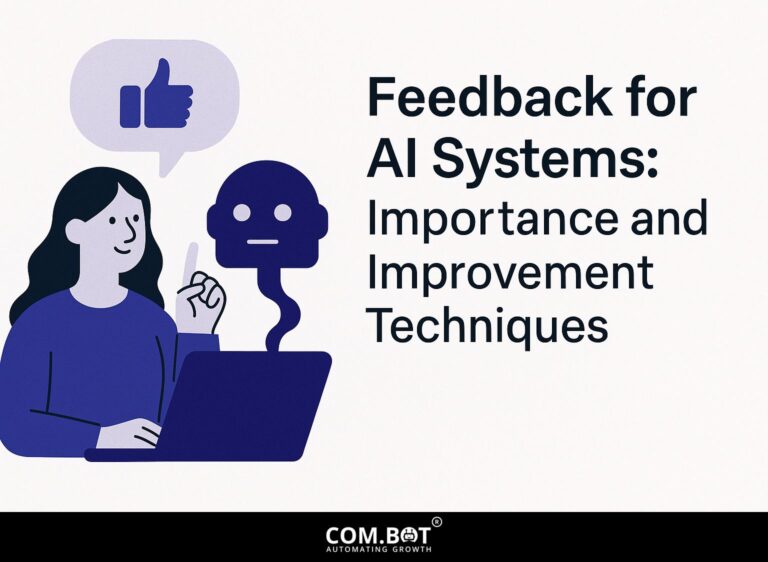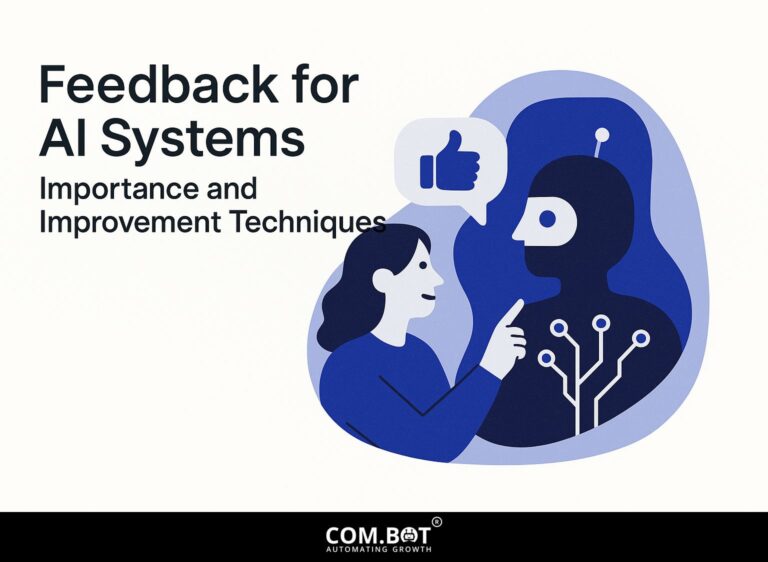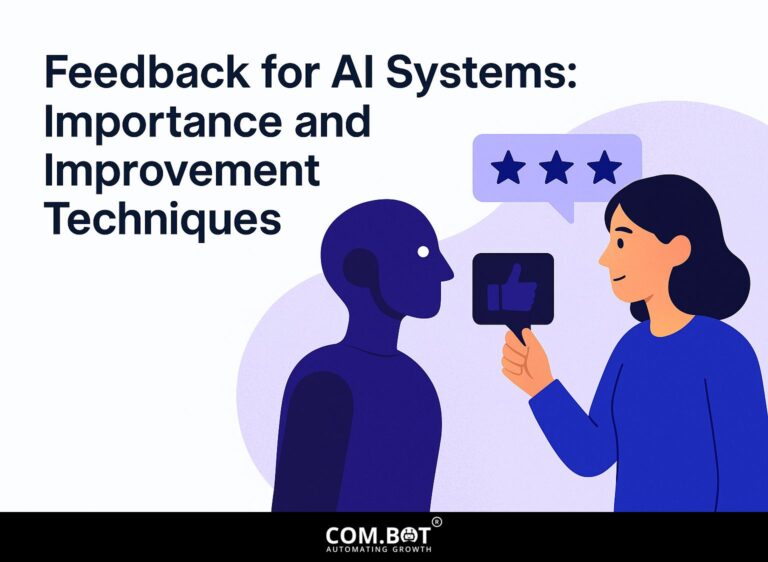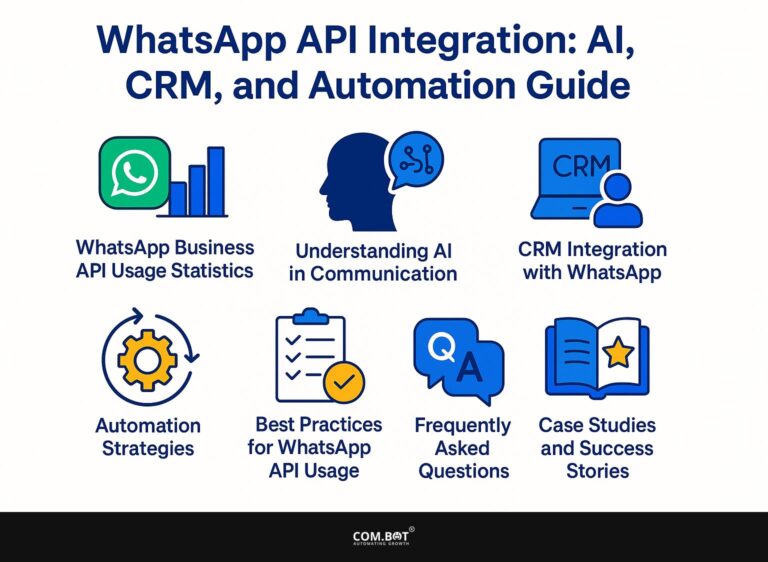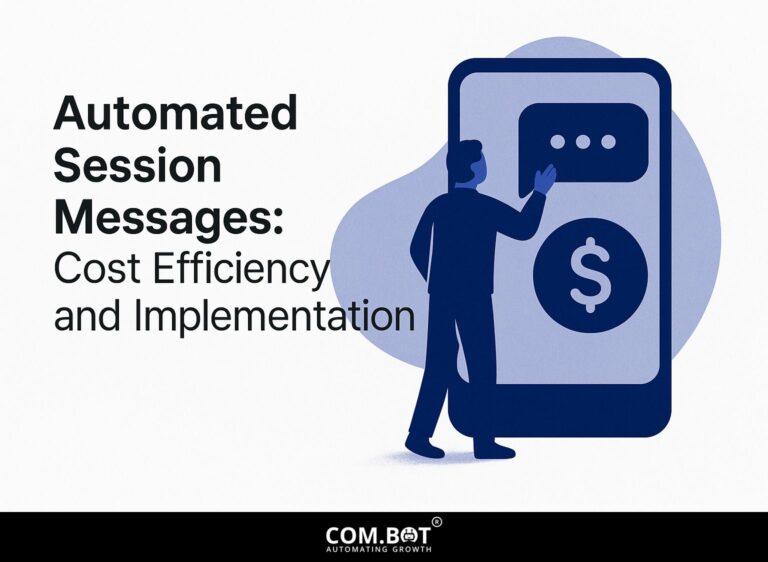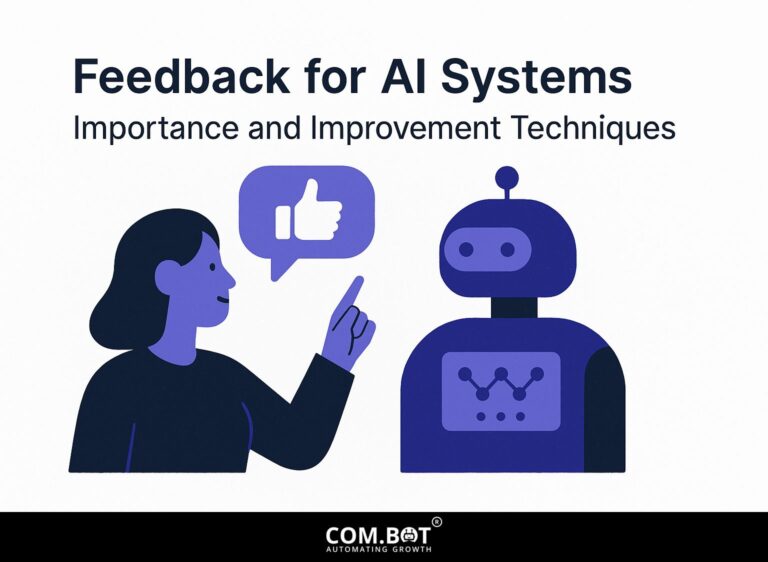Feedback for AI Systems: Importance and Improvement Techniques
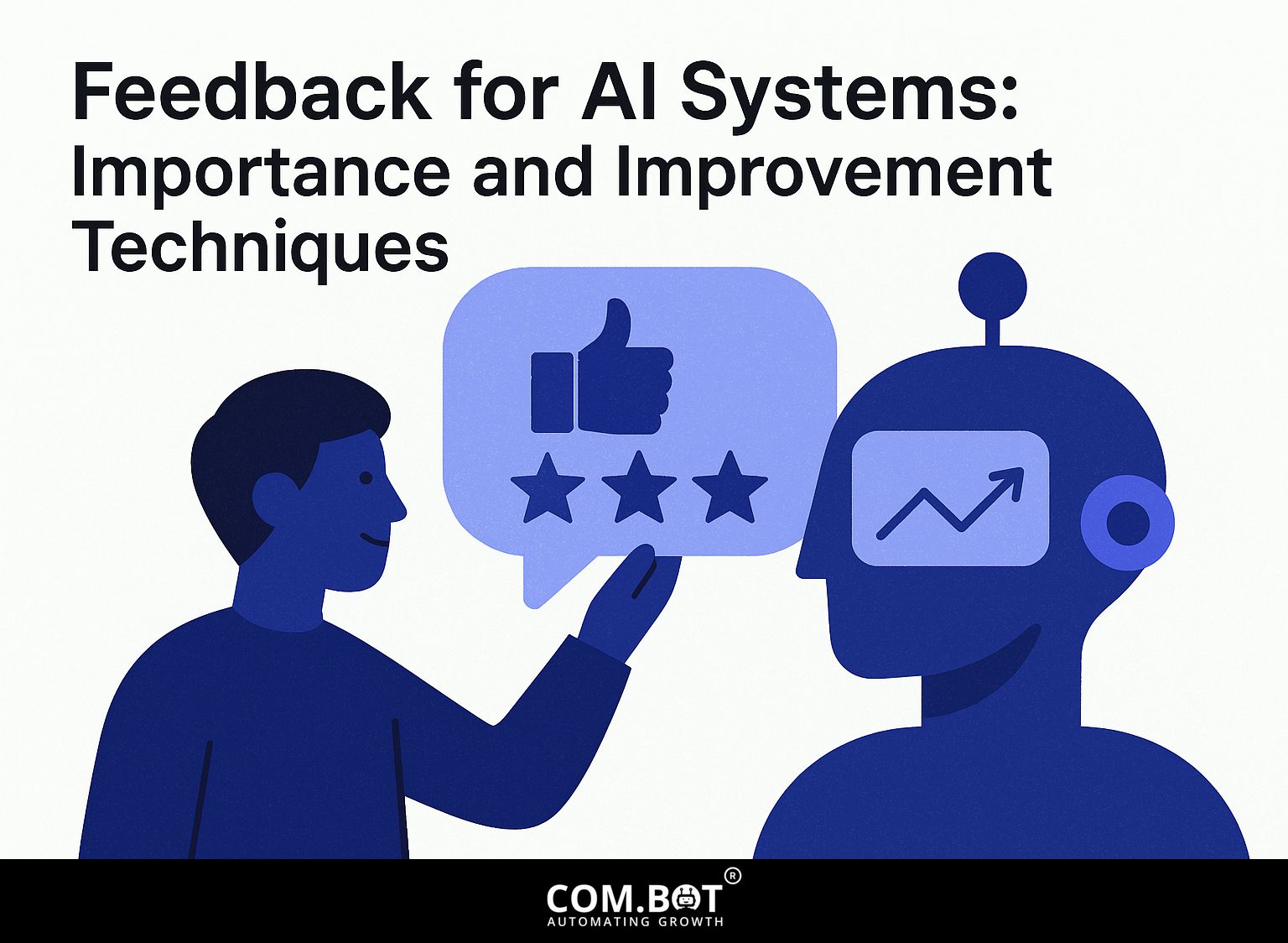
In the fast-changing field of artificial intelligence, giving good feedback is key to improving AI systems. By watching how users interact and studying performance data, developers can improve their algorithms and make the system more accurate. This article looks at why feedback is important in AI development and gives practical methods to make AI work better and gain user trust. Learn how using well-planned feedback systems can make your AI projects more responsive and dependable.
Key Takeaways:
- 1 Importance of Feedback in AI Systems
- 2 Types of Feedback Mechanisms
- 3 AI Feedback Mechanism Statistics
- 4 Feedback Collection Techniques
- 5 Analyzing Feedback Data
- 6 Implementation of Feedback for Improvement
- 7 Challenges in Feedback Implementation
- 8 Frequently Asked Questions
- 8.1 What is the importance of feedback for AI systems?
- 8.2 How does feedback contribute to the improvement of AI systems?
- 8.3 What are some common techniques for providing feedback to AI systems?
- 8.4 Why is continuous feedback necessary for AI systems?
- 8.5 What are the potential consequences of not providing feedback to AI systems?
- 8.6 How can human feedback help in improving AI systems?
Definition of Feedback in AI
Feedback in AI means the data and inputs from users that help the system learn and make decisions.
Different kinds of feedback are important for training AI models. User ratings provide quantitative input on performance, helping to direct model adjustments.
Data on user behavior, like how often people click on a link and how long they spend on content, provides useful information about how users interact with it. This can help improve algorithms.
For example, quickly using feedback from users can make recommendation systems better and more suitable.
Comments from customer surveys or reviews can point out areas for improvement, aiding in improving model creation.
Role of Feedback in AI Development
Feedback is important in AI development because it helps with continuous improvement through repeated learning processes.
One effective method for incorporating human feedback is through reinforcement learning, where agents learn optimal behaviors by receiving rewards or penalties.
Tools like Label Studio facilitate this process by allowing users to annotate data, which helps inform AI systems about accuracy and performance.
For example, you can train a chatbot by starting with user interactions. Then, use Label Studio to tag wrong responses, which helps make the model better over time.
This sets up a process that improves predictions and makes the user experience better.
Importance of Feedback in AI Systems
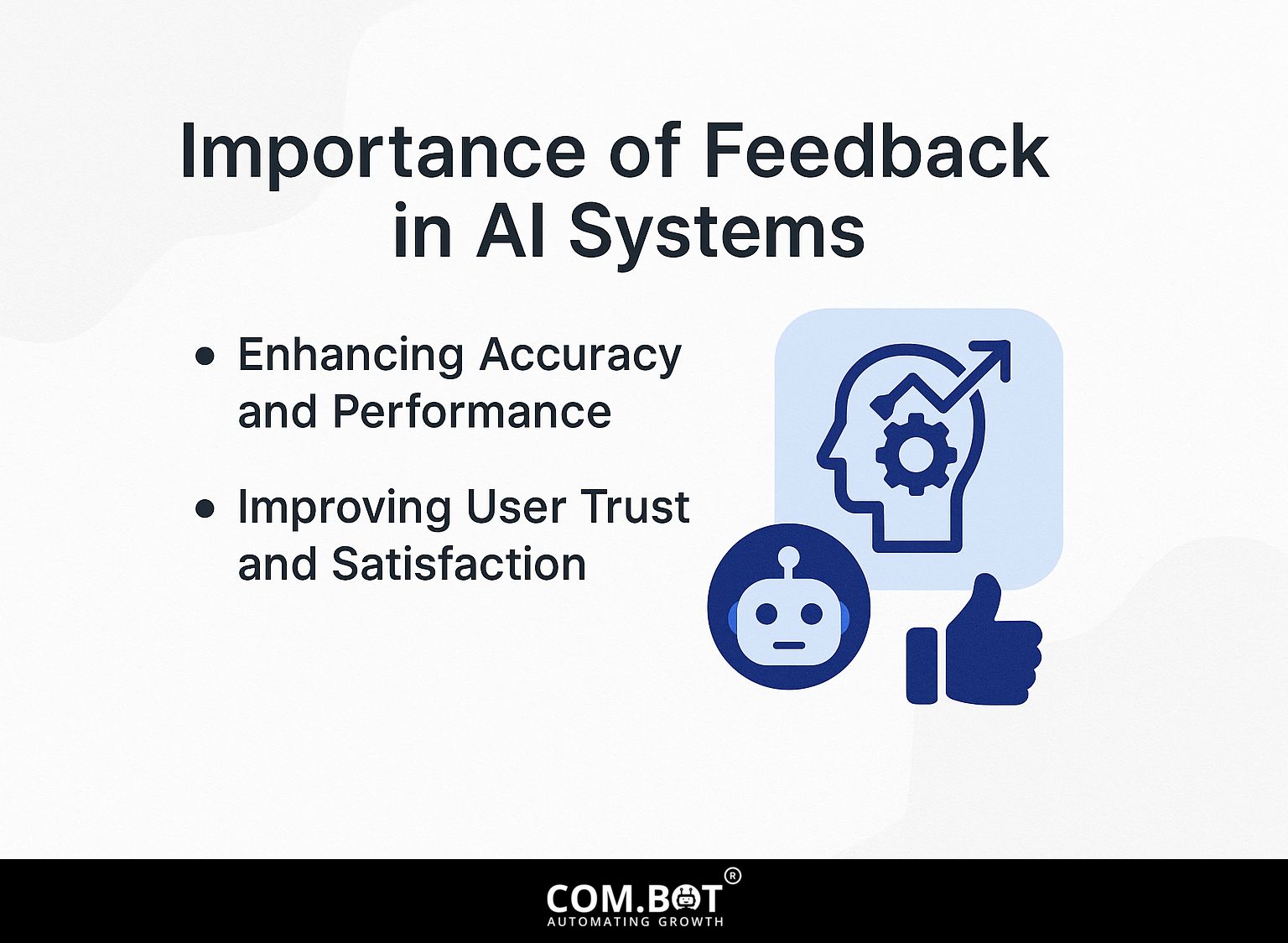
Feedback is important for AI systems, improving accuracy and increasing user trust, which directly affects involvement and satisfaction. Learn more about the importance of feedback and techniques to enhance AI systems and how it can transform user interactions.
Enhancing Accuracy and Performance
Strong feedback systems can make AI up to 30% more accurate, significantly improving the system’s overall performance.
One effective approach involves integrating anomaly detection systems, such as those used in finance.
Systems such as SAS Visual Analytics use user feedback to find strange transactions. When a user marks a transaction as questionable, the system uses this data to make its processes better for detecting similar issues later.
Employing tools like TensorFlow allows for continuous learning and model updates based on user interactions. Repeating this method improves accuracy and boosts user trust, allowing AI systems to handle daily situations more effectively.
Improving User Trust and Satisfaction
Incorporating user feedback effectively can increase satisfaction rates by 50%, leading to greater engagement with AI systems.
E-commerce websites often use customer reviews to improve their products and gain trust. For instance, a leading online retailer implemented feedback loops through post-purchase surveys, enabling them to identify and resolve pain points.
After including more positive customer reviews and ratings, they experienced a 30% rise in product ratings and a 20% increase in repeat purchases within six months.
Tools like Trustpilot or Yotpo help by gathering and displaying real customer opinions, which improves clarity and strengthens brand loyalty.
Types of Feedback Mechanisms
Knowing various kinds of feedback systems helps make AI systems better and improve how users interact with them. These techniques are crucial for implementing effective AI feedback mechanisms, as detailed in our analysis of Feedback for AI Systems: Importance and Improvement Techniques.
AI Feedback Mechanism Statistics
AI Feedback Mechanism Statistics
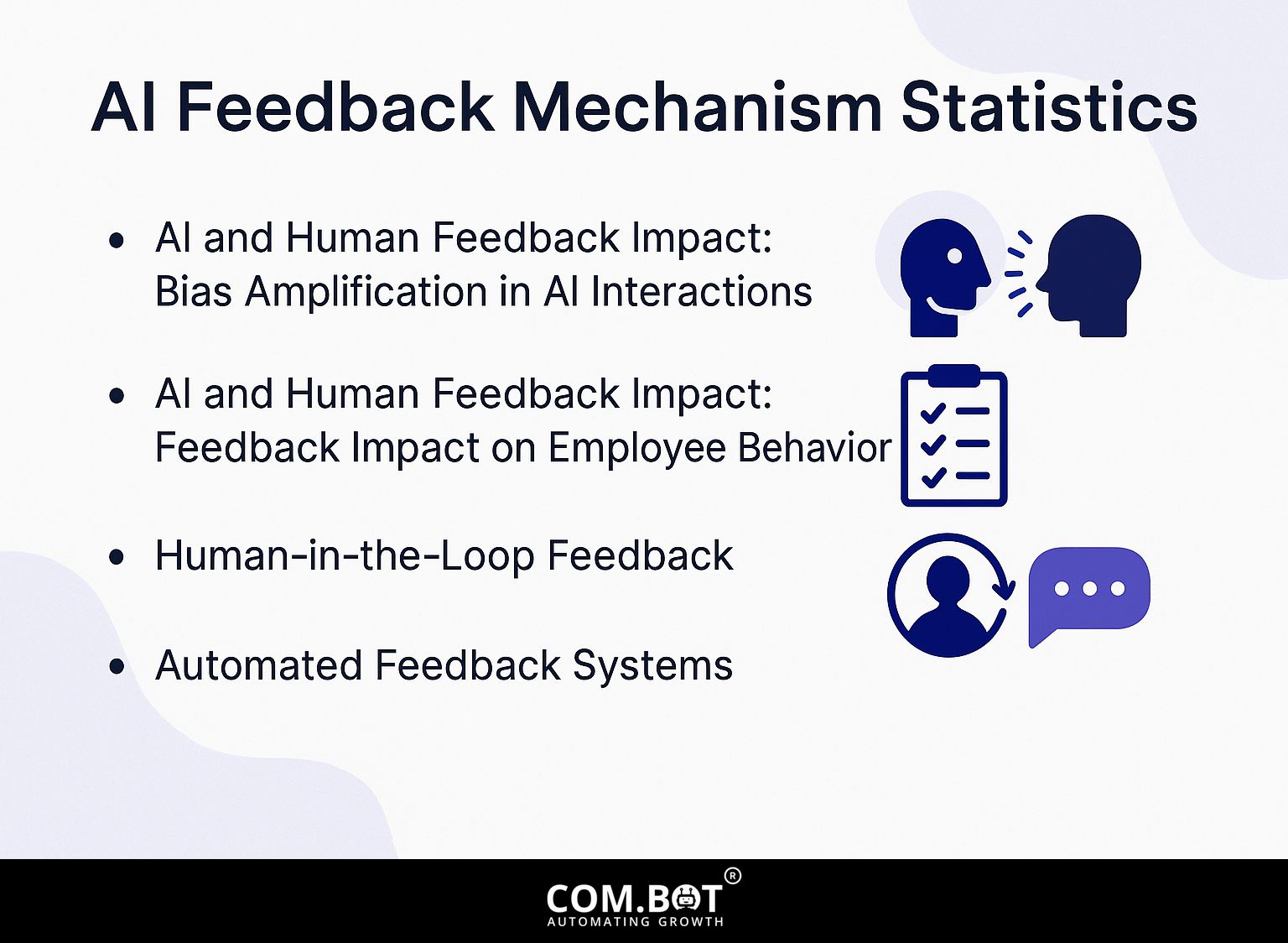
AI and Human Feedback Impact: Bias Amplification in AI Interactions
AI and Human Feedback Impact: Feedback Impact on Employee Behavior
The AI Feedback Mechanism Statistics look into how AI communication affects how people act and how feedback affects how well employees do their jobs. These statistics show how AI systems influence biases and employees’ belief in their abilities, highlighting more human bias and how feedback changes work behavior.
AI and Human Feedback Impact highlights the phenomenon of bias amplification in AI interactions. When humans interact with biased AI systems, their biases can increase by 65.33%, compared to a baseline human bias of 53.08%. Interestingly, AI using Convolutional Neural Networks (CNN) has a chance level bias amplification of 50.0%, which suggests that even unbiased AI can influence human biases, albeit to a lesser degree than biased AI.
- In terms of Feedback Impact on Employee Behavior, AI negative feedback can slightly reduce self-efficacy by -0.18%, indicating that negative AI feedback can affect employees’ perception of their abilities. Leader feedback, on the other hand, has a 0.10% impact on work withdrawal through feelings of shame, suggesting that emotional responses to leader feedback are significant.
- AI feedback influences work withdrawal via self-efficacy at 0.08%, demonstrating that AI can indirectly affect employee engagement. However, when employees have a lot of AI knowledge, AI feedback boosts their confidence more. 0.45% Compared to leader feedback, which highlights the importance of knowing AI systems in managing feedback effectively.
This information shows that AI interactions can increase existing biases and influence how employees perform through feedback systems. Controlling how AI behaves and making sure AI systems are fair are important to reduce the increase of bias. Also, knowing how AI feedback impacts self-confidence is key to improving employee involvement and efficiency.
Human-in-the-Loop Feedback
Human-in-the-loop feedback includes human judgment in AI training, helping systems learn more effectively for real-world situations.
This method is important in healthcare, where algorithms need to accurately understand patient details.
For instance, using Label Studio, healthcare professionals can annotate medical images, providing feedback that trains the AI to distinguish between healthy and abnormal findings. This dual approach improves the AI’s accuracy and keeps it in line with ethical standards.
Tools like Prodigy help developers improve model predictions by using human feedback, leading to ongoing improvements and better choices in important applications.
Automated Feedback Systems
Systems that automatically provide feedback use algorithms to collect and analyze data continuously, which helps make quick decisions in AI programs.
These systems often integrate tools like Google Analytics, which tracks user behavior and website performance. By setting up specific conversion goals, you can determine which content is most effective.
Platforms like Mixpanel give detailed information on user activities, helping to make specific changes in strategy. Using these analytics tools with AI models allows behavior to change based on new data.
Create a system that allows feedback to update algorithms, ensuring your AI adapts quickly to what users want and like.
Feedback Collection Techniques
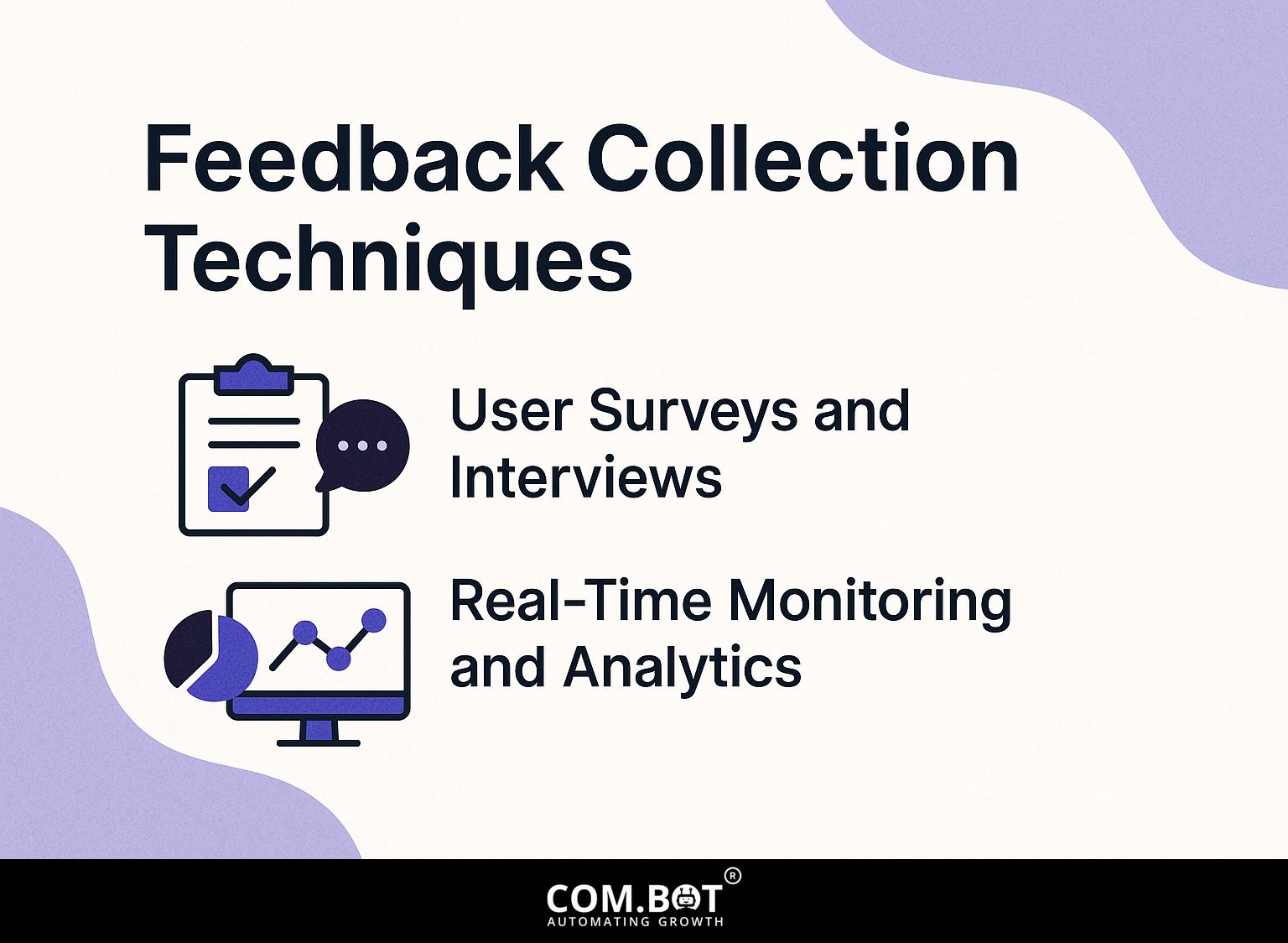
Collecting feedback effectively is important for gathering useful user information that guides AI development. To delve deeper into this topic, our comprehensive exploration of feedback techniques for AI systems offers insights into the methods and their importance in refining AI capabilities.
User Surveys and Interviews
Surveys can provide useful information. Well-made questionnaires can result in a 60% response rate, allowing for more detailed data collection.
To write effective survey questions, make sure they are easy to understand and directly related to the topic. Begin with broad questions to gather detailed feedback, like “Which features do you appreciate the most?”
Follow with closed questions for quantitative data, like a 1-5 rating scale for satisfaction. Use tools like SurveyMonkey or Google Forms to send out your survey; both have templates to make the process easier.
Once data is collected, categorize feedback to identify trends and inform improvements in your AI algorithms. Analyzing feedback can take less than a week, greatly enhancing user experience.
Real-Time Monitoring and Analytics
Tools like Mixpanel provide immediate information on how users engage, allowing for fast changes to AI systems.
To set up an effective monitoring dashboard, start by defining key performance indicators (KPIs) specific to your AI’s objectives, like user engagement or conversion rates.
Use Mixpanel’s interface to create segmented funnels that track user behavior over time. Regularly reviewing these metrics allows you to identify trends and pain points.
If data shows users leaving at a certain point in their experience, test different prompts or features to keep them engaged. Regularly reviewing data and making adjustments significantly boosts AI performance.
Analyzing Feedback Data
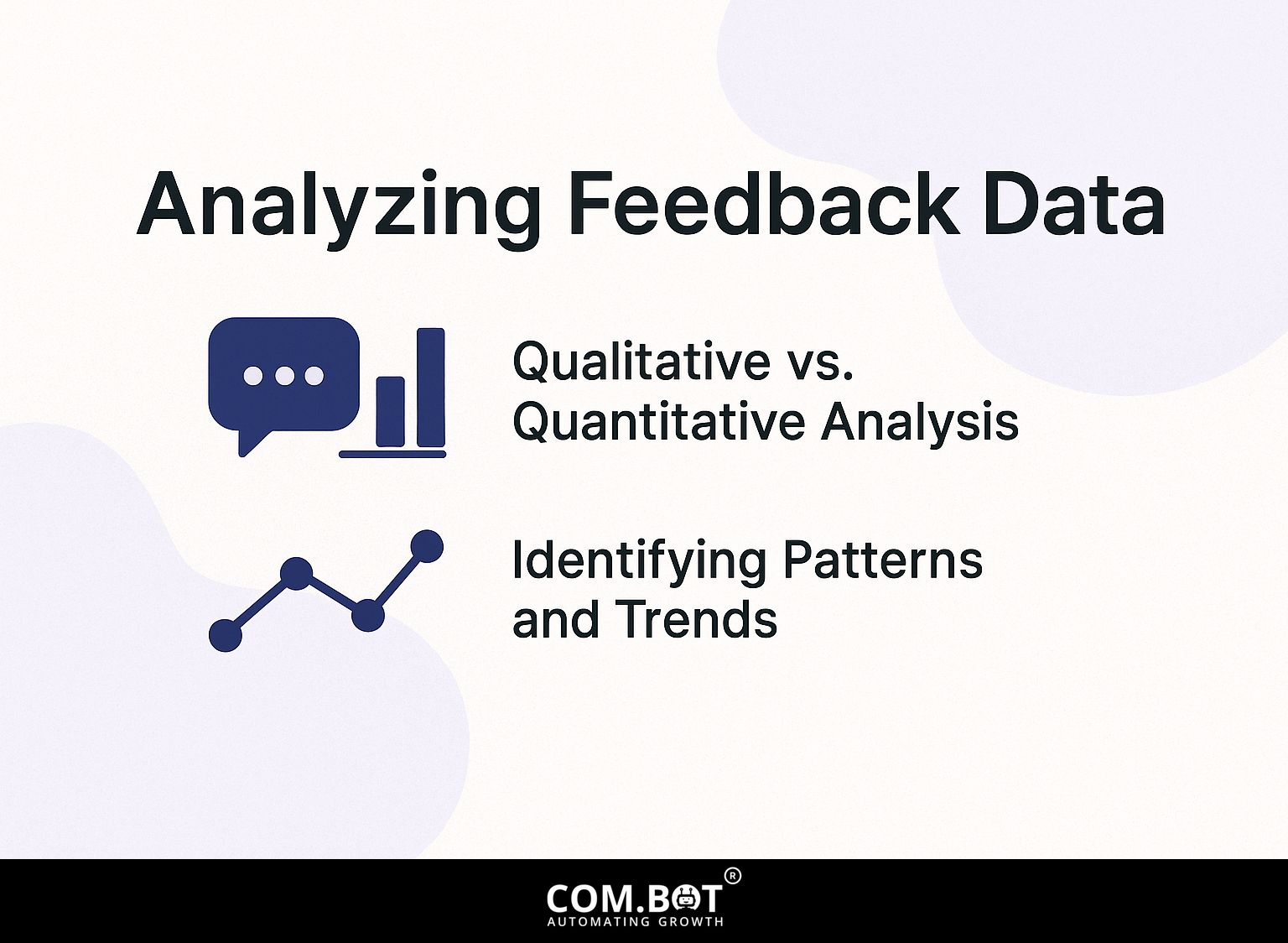
Studying feedback information is important for finding trends that help improve AI and make the user experience better. Curious about how these feedback techniques can enhance AI systems? Our analysis explains the key factors.
Qualitative vs. Quantitative Analysis
Qualitative analysis looks at what users feel, while quantitative analysis offers solid numbers. Both are important for a complete feedback plan.
Qualitative analysis helps in figuring out how users emotionally react. For example, doing interviews or asking open-ended survey questions can reveal detailed information about user experiences.
Tools like UserTesting or Qualtrics facilitate this type of analysis. In contrast, quantitative analysis provides numerical data that helps track trends and measure performance.
A/B testing or Google Analytics allows you to gather data on user engagement numbers. Using both techniques shows clearly how users behave, combining emotions with concrete facts to make better decisions.
Identifying Patterns and Trends
Using data visualization tools such as Tableau can show important patterns and trends that help improve AI performance.
To effectively identify patterns in feedback data, start by collecting diverse data sets from user interactions, such as click rates and error reports.
Use Tableau’s drag-and-drop tool to make visual dashboards that show relationships and unusual patterns. For instance, compare performance metrics across different AI algorithms to visualize which method yields the best results.
Integrating tools like Google Analytics can provide real-time feedback, allowing for immediate adjustments. Regularly review these visuals to make informed decisions about improving AI systems and enhancing user experiences.
Implementation of Feedback for Improvement
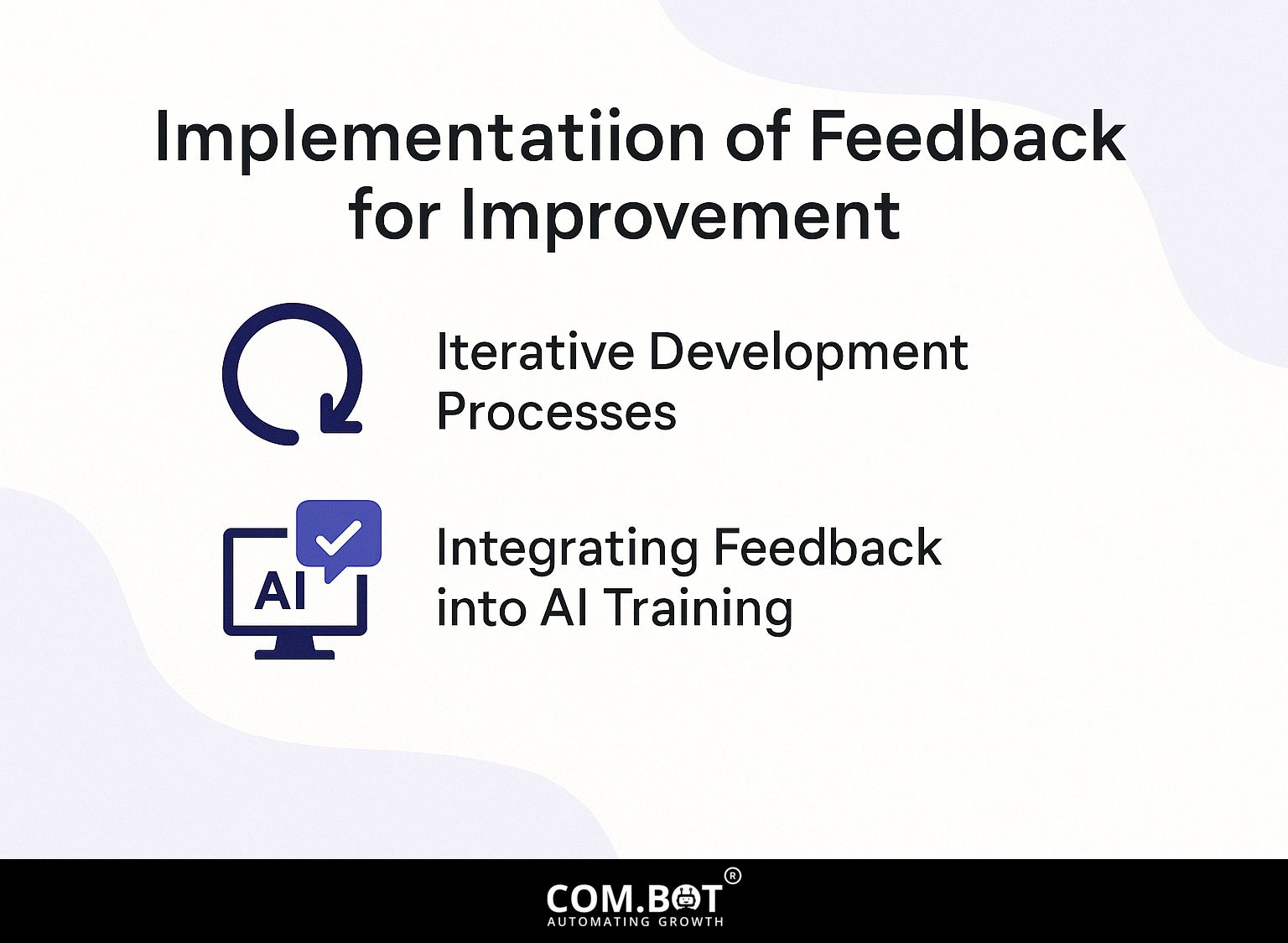
To effectively use feedback, follow a clear method to include the findings into the AI development process.
Iterative Development Processes
AI models improve by using ongoing feedback to increase their accuracy.
To hold useful feedback meetings, include different people such as developers, product managers, and the people who use the product.
Start by presenting the current model performance, followed by specific areas where feedback is sought.
Use tools like Miro or Jamboard to work together live on ideas and recommendations.
Schedule regular sessions-ideally bi-weekly-to discuss progress and adjust objectives.
By creating a welcoming space where team members feel appreciated, you improve the quality of feedback, which leads to ongoing progress in your AI projects.
Integrating Feedback into AI Training
Including feedback from users in AI training can make models work better by ensuring machine learning aligns with practical requirements.
To effectively use feedback, consider these three practical steps:
- Implement a feedback collection mechanism, such as user surveys or real-time data analysis, which can be facilitated through tools like SurveyMonkey or Google Forms.
- Analyze this data to identify trends and gaps in performance. For instance, in healthcare, a hospital used patient feedback to improve a symptom-checking AI, leading to a 30% increase in accuracy.
- Frequently update your model with this improved dataset to keep it aligned with what users want and to maintain its usefulness.
Challenges in Feedback Implementation
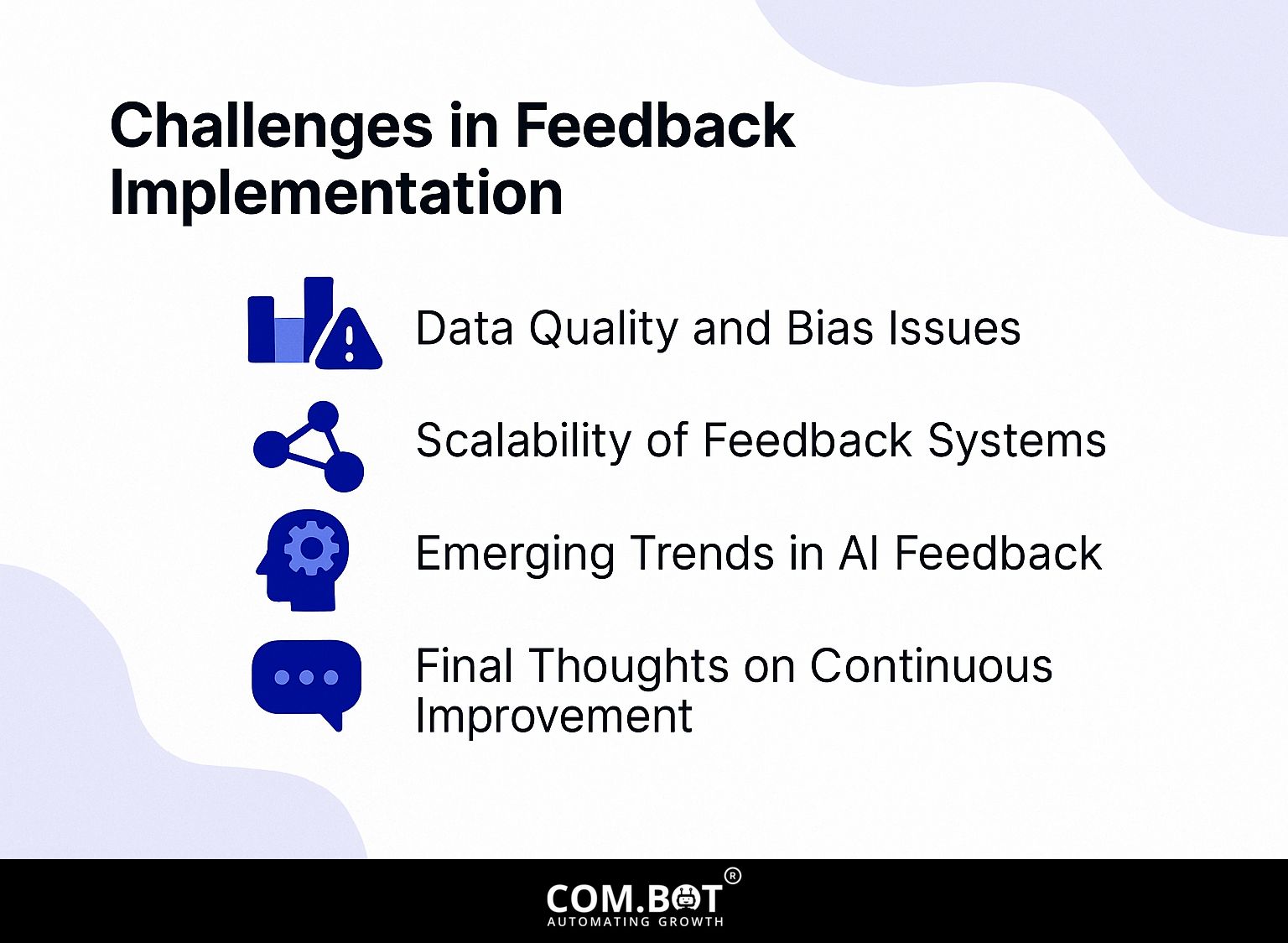
It’s important to include feedback in AI systems, but companies often face challenges that can make this hard. To effectively navigate these challenges, understanding the importance and improvement techniques for feedback in AI systems is crucial.
Data Quality and Bias Issues
Problems with data quality and bias can greatly affect how well AI works. Strong management approaches are needed to make sure it works fairly and correctly.
To reduce these risks, think about using datasets labeled by people to give context and accuracy. Regular audits of feedback sources, such as user reports and model outputs, are essential for identifying bias.
You can employ tools like Amazon SageMaker for creating and maintaining quality data by integrating checks throughout the data pipeline. Holding regular training sessions for your AI model using various datasets can improve its ability to work well and fairly across different groups.
These strategies together improve the dependability and honesty of systems that use AI.
Scalability of Feedback Systems
Scalability creates specific difficulties in feedback systems, requiring flexible structures that can expand with user interactions.
To create systems that handle growing feedback, think about using cloud services like AWS or Google Cloud. These provide tools that can handle more data as needed.
Use microservices in distributed systems to separate feedback processing from data storage, making the system more flexible.
Tools like Apache Kafka can aid in handling real-time data streams, while platforms such as Microsoft Azure provide machine learning capabilities for analyzing user feedback trends.
These methods keep your system quick and able to handle large user demand.
Emerging Trends in AI Feedback
Emerging trends like reinforcement learning and advanced data visualization are reshaping how feedback is integrated into AI systems.
Organizations can use these advancements by applying tools like TensorFlow for reinforcement learning models that change based on user interactions, helping systems to get better over time.
Using data visualization tools like Tableau or Power BI can help teams review feedback patterns and find areas that need improvement. For instance, a customer service AI could use real-time feedback to adjust its responses, enhancing user satisfaction.
By using these technologies together, companies can create a feedback loop that constantly improves the user experience.
Final Thoughts on Continuous Improvement
Constant progress is key to successful AI use, supported by feedback systems that respond to user needs.
To achieve this, organizations should implement structured feedback loops involving polls, user reviews, and data analytics.
For example, utilizing tools like SurveyMonkey for real-time user feedback can identify areas of improvement quickly. Using Google Analytics helps teams monitor how users interact with their site and understand behavior patterns.
Checking this data often helps algorithms to change based on real user experiences, improving how well they work and how satisfied users are. This repeated process creates a more responsive AI system that meets and predicts user needs.
Frequently Asked Questions
What is the importance of feedback for AI systems?
Feedback is important for AI systems because it helps them keep learning and getting better. It helps in identifying and correcting errors, improving accuracy, and enhancing the overall performance of the system.
How does feedback contribute to the improvement of AI systems?
Feedback gives useful information to AI systems, which they use to improve their algorithms and make better predictions. This leads to improved decision-making and better results.
What are some common techniques for providing feedback to AI systems?
Some common techniques for providing feedback to AI systems include manual labeling of data, active learning, reinforcement learning, and human-in-the-loop systems. Each technique has its own benefits and is used for different purposes.
Why is continuous feedback necessary for AI systems?
AI systems are constantly exposed to new and changing data, which can affect their performance. Regular feedback helps the system adjust to changes and become more accurate as time passes.
What are the potential consequences of not providing feedback to AI systems?
Without feedback, AI systems may make incorrect predictions and decisions, which can have serious consequences. This can range from financial losses to safety risks and damage to the system’s credibility.
How can human feedback help in improving AI systems?
Human feedback is important in training AI systems because it gives information and context that data alone might not offer. It can also help in identifying and correcting biases and errors in the system’s algorithms.
